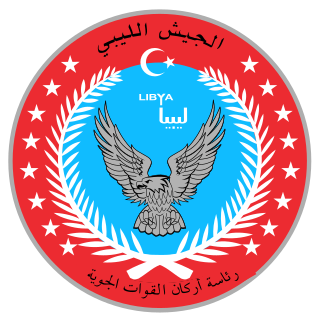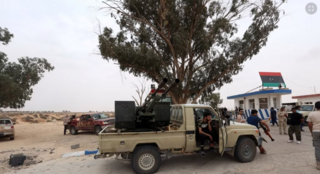
The Storm Shadow is a Franco-British low-observable, long-range air-launched cruise missile developed since 1994 by Matra and British Aerospace, and now manufactured by MBDA. "Storm Shadow" is the weapon's British name; in France it is called SCALP-EG. The missile is based on the French-developed Apache anti-runway cruise missile, but differs in that it carries a unitary warhead instead of cluster munitions.

The Egyptian Air Force (EAF) (Egyptian Arabic: القوات الجوية المصرية, romanized: El Qūwāt El Gawīyä El Maṣrīya, Coptic: Ⲛⲉⲛⲡⲉⲧϩⲁⲗⲁⲓⲛⲙⲓϣⲓ ⲛ̀ⲕⲏⲙⲓ), is the aviation branch of the Egyptian Armed Forces that is responsible for all airborne defence missions and operates all military aircraft, including those used in support of the Egyptian Army, Egyptian Navy and the Egyptian Air Defense Forces. The latter was created as a separate command in the 1970s and it coordinates with the Air Force to integrate air and ground-based air defense operations. The EAF is headed by an air marshal (lieutenant general equivalent). Currently, the commander of the Egyptian Air Force is Air Marshal Mahmoud Fouad Abdel-Gawad. The force's motto is 'Higher and higher for the sake of glory' (Arabic: إلى العلا في سبيل المجد, I‘la’ al-'olà fī sabīl al-magd). It was known as the Royal Egyptian Air Force until 18 June 1953 following the declaration of the Republic of Egypt by Muhammad Naguib.

The Raytheon MIM-23 HAWK is an American medium-range surface-to-air missile. It was designed to be a much more mobile counterpart to the MIM-14 Nike Hercules, trading off range and altitude capability for a much smaller size and weight. Its low-level performance was greatly improved over Nike through the adoption of new radars and a continuous wave semi-active radar homing guidance system. It entered service with the US Army in 1959.

The Libyan Air Force is the branch of the Libyan Armed Forces responsible for aerial warfare. In 2010, before the Libyan Civil War, the Libyan Air Force personnel strength was estimated at 18,000, with an inventory of 374 combat-capable aircraft operating from 13 military airbases in Libya. Since the 2011 civil war and the ongoing conflict, multiple factions fighting in Libya are in possession of military aircraft. As of 2019 the Libyan Air Force is nominally under the control of the internationally recognised Government of National Accord in Tripoli, though the rival Libyan National Army of Marshal Khalifa Haftar also has a significant air force. In 2021, the air force is under command of the new President of Libya, Mohamed al-Menfi that replaced Fayez al-Sarraj.

The Pantsir missile system is a family of self-propelled, medium-range surface-to-air missile and anti-aircraft artillery systems. Three types of vehicles make up one system: a missile launcher, a radar truck and a command post. Starting with the Pantsir-S1 as the first version, it is produced by KBP Instrument Design Bureau of Tula, Russia, and is the successor to the Tunguska M1.

The Libyan civil war (2014–2020), also more commonly known as the Second Libyan Civil War, was a multilateral civil war which was fought in Libya between a number of armed groups, but mainly the House of Representatives (HoR) and the Government of National Accord, for six years from 2014 to 2020.

Many states began to intervene against the Islamic State, in both the Syrian Civil War and the War in Iraq (2013–2017), in response to its rapid territorial gains from its 2014 Northern Iraq offensives, universally condemned executions, human rights abuses and the fear of further spillovers of the Syrian Civil War. These efforts are called the war against the Islamic State, or the war against ISIS. In later years, there were also minor interventions by some states against IS-affiliated groups in Nigeria and Libya. All these efforts significantly degraded the Islamic State's capabilities by around 2019–2020. While moderate fighting continues in Syria, as of 2024, ISIS has been contained to a manageably small area and force capability.

Opération Chammal is a French military operation in Iraq and Syria launched to help curtail the expansion of the Islamic State of Iraq and the Levant and to support the Iraqi Army. Its name comes from the Shamal, a northwesterly wind that blows over Iraq and the Persian Gulf states.
The February 2015 Egyptian airstrikes in Libya against Islamic State positions in Libya took place on 16 February 2015, and were triggered by a video released by ISIL in Libya a day earlier, depicting the beheading of 21 Coptic Christians from Egypt. Within hours, the Egyptian Air Force responded with airstrikes against ISIL training camps and weapons stockpiles in retaliation for the killings. Warplanes acting under orders from the Libyan government also struck targets in Derna, reportedly in coordination with Egypt.
al-Watiya Air Base also known as Okba Ibn Nafa Air Base is a military airport in the Nuqat al Khams district of western Libya. It was named after Uqba ibn Nafi, the Islamic general who conquered North Africa. It is 27 kilometres (17 mi) east of the Tunisian border and 125 kilometres (78 mi) from Tripoli.

The Government of National Accord was an interim government for Libya that was formed under the terms of the Libyan Political Agreement, a United Nations–led initiative, signed on 17 December 2015. The agreement was unanimously endorsed by the United Nations Security Council, which welcomed the formation of a Presidency Council for Libya and recognized the Government of National Accord as the sole legitimate executive authority in Libya. On 31 December 2015, Chairman of the Libyan House of Representatives, Aguila Saleh Issa declared his support for the Libyan Political Agreement. The General National Congress has criticized the GNA on multiple fronts as biased in favor of its rival parliament the House of Representatives.
This is a detailed timeline of the Libyan civil war (2014–2020) which lasted from 2014 to 2020.
KORAL is a land-based transportable electronic warfare system developed to jam and deceive hostile radars of enemy nations.
On 18 May 2017, an attack was launched by militia men of the town of Misrata and Benghazi Defense Brigades against the Brak al-Shati Airbase controlled by LNA forces. LNA sources claimed 141 people, including 103 soldiers and numerous civilians were killed as a result of the raid. The base was completely overrun and partially destroyed along with numerous aircraft in the base. Accusations of executions of surrendering forces led to international condemnation of GNA forces.

The Western Libya campaign was a military campaign initiated on 4 April 2019 by the Operation Flood of Dignity of the Libyan National Army, which represents the Libyan House of Representatives, to capture the western region of Libya and eventually the capital Tripoli held by the United Nations Security Council-recognised Government of National Accord. The Government of National Accord regained control over all of Tripoli in June 2020 and the LNA forces withdrew from the capital, after fourteen months of fighting.

In 2020, Turkey militarily intervened in support of the United Nations-recognized Government of National Accord (GNA) of Libya in the 2014–2020 Libyan civil war. Military intervention was approved by the Grand National Assembly of Turkey on 2 January 2020, which passed a one-year mandate to deploy troops to Libya. Turkish military deployments to Libya began on 5 January.

The Central Libya offensive, officially known as Operation Paths to Victory, was a military offensive in Libya launched by the forces of the Government of National Accord, to take the city of Sirte and Al Jufra Airbase from the House of Representatives backed by the Libyan National Army. The city of Sirte is considered strategically important because of its close position to oil facilities, which give it control over Libya's oil and gas shipping ports. The Al Jufra Airbase is strategically important for the GNA, due to its central position to Fezzan and denying the Libyan National Army air superiority over Central Libya.

The Egyptian intervention in Libya has been substantial since the beginning of the civil war. The intervention started after the Islamic State of Iraq and the Levant (ISIL) released a video of the beheading of 21 Egyptians on February 12th, 2015. In response, Egypt launched airstrikes on the 16th of February that same year. After that incident, Egypt became increasingly involved with Libya's internal politics.
The Wagner Group, also known as PMC Wagner, a Russian paramilitary organization also described as a private military company (PMC), a network of mercenaries, and a de facto unit of the Russian Ministry of Defence (MoD) or Russia's military intelligence agency, the GRU, has conducted operations in Libya since late 2018.

The Battle of Al-Watiya Airbase in 2020 marked a crucial turning point in the Second Libyan Civil War, as Government of National Accord (GNA) forces sought to reclaim control from the Libyan National Army (LNA) led by General Khalifa Haftar.












